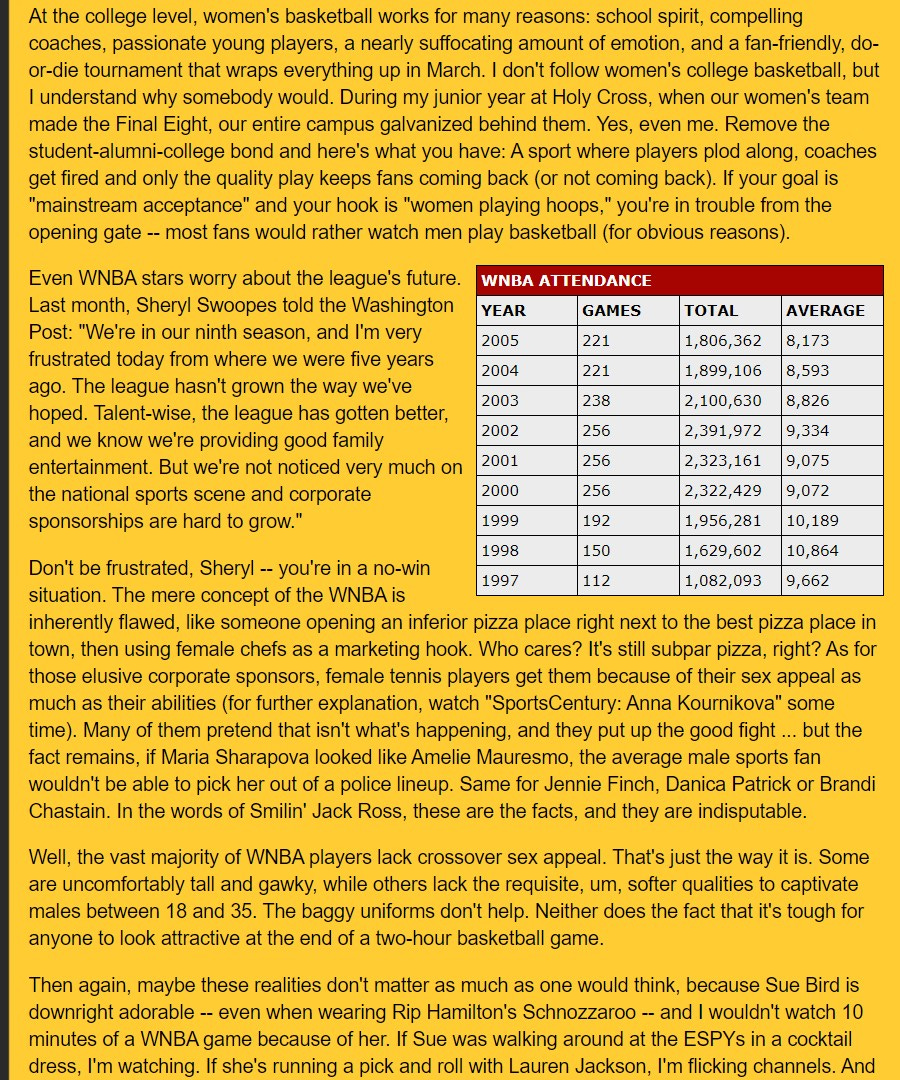The Evolution of Women's Basketball Coverage
I am a Millennial. Specifically, I am a first-wave Millennial, born in the first half of the 1980s, a product of a ‘90s childhood, who came of age at the turn of the millennium — ergo the label.
Revisiting media from the early 2000s today is absolutely jarring. This month marked the 18-year anniversary of the U.S. declaring war on Iraq, and looking back on the cable-news coverage leading up to and into the initial few weeks of the invasion — which more closely resembled the shrill inanity of NFL on FOX pregame than it did the harsh realities of war — welcomes a certain kind of despair for humanity.
That’s a matter of far graver significance than I’m equipped to address in this newsletter, but it does offer a telling backdrop of the age we’re discussing.
So much of what we consumed then was packaged in a sort of fake machismo that included this weird, hyper-sexism. Two more modern takes on media of the day come from the hilarious Sklar Bros. take on the absurdity of Coors Light’s awful And twiiiiiiins! ad campaign, which ESPN opted to incorporate in its NFL coverage circa 2004; and the Hulu documentary “Framing Britney Spears,” tackling the weightier results of sexualized media at the turn of the millennium.
The blogging of Bill Simmons at ESPN.com provides an illuminating time capsule of sports media from this era. I was never a fan, even at The Sports Guy’s peak of popularity, but Simmons’ influence on the tone of early digital sports media is undeniable.
And here’s a snapshot of what the most influential voice of the time thought of women’s basketball.
I don’t draw attention to this to try canceling Bill Simmons over a 15-year-old column. Heaven knows as a teen and early-20-something of the 2000s, I’m guilty of my own ignorance reflective of the time, I’m just fortunate enough to have not had a platform on which to spew it.
No, we’re not here to relitigate archaic opinions in modern context. Rather, I highlight the above to demonstrate how far sports media has come in its presentation of women’s basketball.
ESPN is protective of its properties; around the same time as this Simmons blog graced the cover of ESPN.com, the network canceled the outstanding fictional series Playmakers over concerns it made the NFL look bad. For this to get the play it did, when ESPN was the home of the WNBA and most women’s NCAA contracts suggested tacit endorsement.
Coverage of women’s basketball has made progress. This kind of knuckle-dragging still exists online, but is relegated mostly to social-media trolls and not the front page of the most prominent sports publication.
In 2021, the Worldwide Leader took a step that wouldn’t be fair to deem groundbreaking — the Women’s National Championship Game aired on broadcast TV via CBS before Disney purchased the right. But showcasing the UConn-Iowa Sweet 16 game on ABC is a move in the right direction.
It is indeed headed in the right direction, but nowhere near the destination.
CBS builds its entire March broadcasting schedule around the NCAA Tournament, turning the postseason into a cultural phenomenon. The conditions for March Madness’ rise aligned perfectly, too, with networks buying into the tournament in the 1980s during what I personally consider the Golden Age of college basketball (teaser: Don’t be surprised to something from your humble author on this topic in the not-distant future).
Women’s basketball is at a disadvantage as far as the time the Men’s Tournament has had to establish itself, and only recently emerged from a cultural dark age when sentiment like Simmons’ above was prevalent in the mainstream.
But the quality of the game now is greater than it’s ever been. If you have checked out action in the 2021 Tournament, you’ll notice an uptempo style and teams on which all five players can score. Shooting is on-point and the ball movement is outstanding. It’s entertaining basketball in a way comparable to the men’s game of the 1980s. If there’s ever been a time to buy-in on the game, whether as a spectator or media presenting it, it’s now.
How the game is presented on a macro scale still needs to evolve. Much of the advocacy for this Tournament I have seen from prominent sports media focuses on praising the women at the expense of the men. That’s a losing battle.
Presenting the quality of the play — and, as importantly, the stories of the players themselves — on the strength of its own merit remains a weakness of mainstream sports media. Attempting to build up the Women’s Tournament by disparaging the Men’s isn’t just counterproductive to the intended purpose, but also dismissive of the women in a way, reducing their game to something that has to be either-or with a beloved institution of Americana.
Men’s and women’s sports propping each up is the way forward. When several NBA stars took to the Orlando bubble last summer wearing orange WNBA hoodies, it was a small gesture with big impact.
Arizona football put out a cool video showing its celebration of the Wildcats’ Elite Eight game on Monday.


In the same vein, I always enjoyed the mutual respect Bruce Pearl and the late, great Pat Summitt showed one another and their programs at Tennessee.
Our culture has made considerable strides in a relatively short time and we’re heading down the right path. The next step comes when we embrace and celebrate greatness without qualifiers or contrasts.




